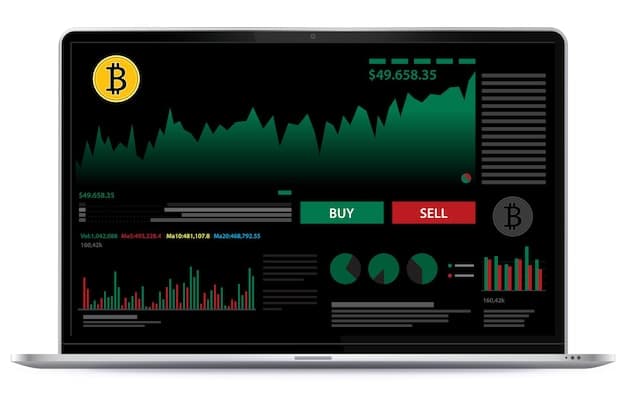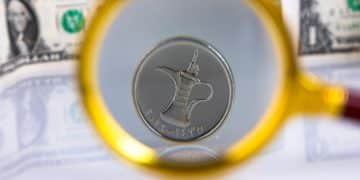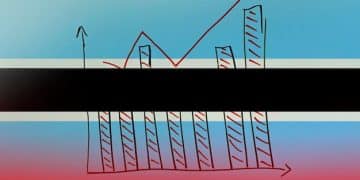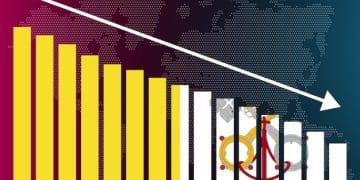Economic Slowdown 2024-2025: Job Security & Income Impact

Anúncios
The projected economic slowdown in late 2024 and early 2025 is anticipated to temper job growth and potentially decrease some income streams due to reduced consumer spending, tighter credit conditions, and a conservative corporate outlook, compelling both individuals and businesses to adopt proactive financial strategies.
Anúncios
As the global economy navigates a complex period of persistent inflation, rising interest rates, and geopolitical uncertainties, a critical question arises for many individuals and households: how will the projected economic slowdown in late 2024 and early 2025 impact job security and income? This is a concern that touches the core of personal finance and stability, demanding a thoughtful exploration of potential challenges and strategic responses.
Understanding the Economic Slowdown Forecast
The anticipation of an economic slowdown in late 2024 and early 2025 stems from a confluence of macroeconomic factors that have been gathering momentum. Central banks globally have aggressively tightened monetary policy in an effort to combat inflation, pushing interest rates to levels not seen in over a decade. This deliberate cooling of the economy, while necessary to stabilize prices, inherently carries the risk of dampening demand and investment.
Furthermore, persistent supply chain disruptions, geopolitical tensions, and ongoing energy market volatility continue to exert pressure on business costs and consumer prices. These elements create a challenging environment where growth becomes harder to sustain.
Anúncios
Key Indicators Pointing to a Slowdown
Several economic indicators are signaling a potential deceleration. Consumer spending, a major driver of economic activity, shows signs of moderation as households grapple with higher borrowing costs and elevated living expenses. Business investment, too, may pull back in response to increased uncertainty and tighter credit conditions.
- Interest Rate Hikes: Central banks’ sustained efforts to control inflation through higher rates make borrowing more expensive for both consumers and businesses, reducing investment and consumption.
- Inflationary Pressures: While some inflation may recede, stubbornly high prices for essential goods like food and energy erode purchasing power, leading to reduced discretionary spending.
- Global Geopolitical Events: Ongoing conflicts and trade tensions can disrupt supply chains, increase commodity prices, and add to overall economic uncertainty.
- Decreased Consumer Confidence: A pessimistic outlook on the economy can lead consumers to save more and spend less, further slowing economic activity.
The nuanced interplay of these factors suggests a period of more restrained economic growth. It’s not necessarily a call for widespread panic but rather a prudent anticipation of leaner times, requiring strategic adjustments from individuals and businesses alike. Predicting the exact magnitude and duration of a slowdown is challenging, but acknowledging its potential allows for better preparedness.
The discussion around “soft landings” versus “hard landings” continues among economists, highlighting the delicate balance central banks are trying to achieve. A soft landing would imply a modest, controlled slowdown that avoids a deep recession, whereas a hard landing would involve a more significant contraction. Regardless of the precise trajectory, the prevailing sentiment is one of reduced momentum, which inevitably has ripple effects on the labor market and personal finances.
Impact on Job Security
Job security often becomes a paramount concern during economic slowdowns. Businesses, facing declining demand and higher operational costs, tend to become more cautious about hiring and may even resort to layoffs to manage overheads.
Sectors Most Vulnerable to Job Losses
Historically, certain sectors are more susceptible to the adverse effects of an economic downturn. Industries heavily reliant on discretionary consumer spending, such as retail, hospitality, and entertainment, often see a significant decline in demand. Manufacturing, particularly sectors tied to construction or large capital expenditures, can also feel the pinch as investment slows.
- Technology: While often seen as resilient, the tech sector has recently experienced significant layoffs, reflecting an overzealous expansion during the pandemic and a subsequent re-evaluation of growth prospects in a tighter funding environment.
- Real Estate and Construction: Rising interest rates directly impact mortgage demand and construction projects, leading to potential contractions in these industries.
- Financial Services: A slowdown can reduce transaction volumes and investment banking activities, affecting employment in this sector.
Smaller businesses, which often operate with tighter margins and less access to capital, may also be particularly vulnerable. Their ability to absorb reduced revenue or increased costs is more limited, potentially leading to faster employment adjustments.
On the other hand, certain essential services and sectors tend to be more resilient, such as healthcare, utilities, and education, as demand for these remains relatively stable regardless of economic conditions. Government employment also typically offers greater stability during downturns.

Strategies for Enhancing Job Security
Proactive measures can significantly enhance an individual’s job security during uncertain economic times. Focusing on skill development, adaptability, and networking are crucial steps.
One key strategy is to continuously upgrade and diversify one’s skillset. Acquiring new competencies, especially in areas that are less susceptible to economic fluctuations (like cybersecurity, renewable energy, or specialized healthcare roles), can make an individual more indispensable to their current employer or more marketable in the broader job market.
Building a robust professional network is another vital step. Strong connections can provide early warnings about industry trends, potential opportunities, or even direct referrals if a job search becomes necessary. Attending industry events, joining professional associations, and leveraging online platforms like LinkedIn can facilitate networking.
Demonstrating value within one’s current role is also paramount. This includes taking on additional responsibilities, proactively identifying and solving problems, and contributing to cost-saving initiatives. Being a high-performing and adaptable employee can make a significant difference when difficult decisions about staffing are made. Preparing an updated resume and practicing interview skills, even if not actively job searching, provides a sense of readiness and reduces stress if a career transition becomes necessary.
Impact on Income
An economic slowdown almost invariably influences personal income. This impact can manifest in various ways, from slower wage growth to reduced bonuses, and in more severe cases, job loss leading to a complete cessation of income.
Wage Growth and Salary Expectations
During periods of economic contraction or slow growth, wage increases tend to decelerate. Companies may pull back on salary adjustments to manage costs, and competition for existing jobs can temper demands for higher pay. This means that even employed individuals might not see their income keep pace with inflation, leading to a real-term decrease in purchasing power.
For those entering the job market or seeking new employment, starting salaries might be lower than in booming economic periods. Bargaining power diminishes when employers have a larger pool of qualified candidates to choose from. Annual performance reviews may result in lower raises or even none at all, shifting the focus from growth incentives to cost containment.
Variable Income and Bonuses
Many professions, particularly in sales, finance, and executive roles, include a significant portion of income derived from bonuses, commissions, or profit-sharing. In a slowdown, corporate profits can shrink, directly impacting the size and frequency of these variable payments. Dividends from investments might also decrease as company earnings are squeezed.
Freelancers and gig economy workers may experience a reduction in available projects and lower rates as businesses cut back on external spending. The demand for contract work often fluctuates more drastically with economic cycles, making this income stream less predictable during a downturn.
Strategies for Protecting and Diversifying Income
Protecting and diversifying income streams is crucial during an economic slowdown. This involves a multi-pronged approach that includes financial planning, skill development, and exploring supplementary income sources.
Firstly, building an emergency fund is non-negotiable. Ideally, this fund should cover 3 to 6 months of essential living expenses. This financial cushion provides a buffer against unexpected job loss or significant income reduction, preventing reliance on high-interest debt.
Secondly, consider developing a secondary source of income. This could be through freelancing, consulting, part-time work, or even turning a hobby into a small business. Having diversified income streams reduces reliance on a single employer, significantly enhancing financial resilience. This can be especially valuable if the secondary income is insulated, to some extent, from the primary economic forces affecting your main job.
Thirdly, review and optimize your personal budget. Identify areas where expenses can be reduced or eliminated. This might involve cutting discretionary spending, renegotiating service contracts, or finding more cost-effective alternatives for recurring expenses. A leaner budget means your emergency fund will last longer if needed, and any income reduction will have less severe consequences.
Finally, continue to invest in your skills and education. This not only enhances job security but can also open doors to new income opportunities or promotions, even during a slowdown. Lifelong learning is a powerful tool for financial stability in a dynamic economic landscape.
Consumer Response and Spending Habits
The economic outlook significantly shapes consumer behavior. As uncertainty about job security and income rises, individuals typically become more cautious with their spending and prioritize saving.
Shifts in Consumer Spending
During a slowdown, discretionary spending — on items like dining out, travel, luxury goods, and non-essential entertainment — often sees a marked decline. Consumers reduce non-essential purchases and focus more on necessities. This shift impacts businesses that rely on these discretionary expenditures, leading to reduced revenue and potential job cuts in those sectors.
There’s also a tendency to prefer value-for-money products and services. Bargain hunting, opting for generic brands, and delaying large purchases become more common. This ‘flight to value’ can put pressure on premium brands and make the retail landscape more competitive.
- Reduced Discretionary Spending: Households cut back on non-essential items like vacations, eating out, and big-ticket purchases.
- Increased Savings Rate: Faced with uncertainty, consumers often increase their savings to build a stronger financial buffer.
- Shift to Essential Goods: Spending prioritizes food, housing, utilities, and healthcare.
- Delaying Major Purchases: Big investments like new cars, appliances, or home renovations are often postponed.
Consumer confidence indices often plummet during these periods, reflecting widespread anxiety. This lack of confidence can create a self-fulfilling prophecy, where reduced spending further exacerbates the economic downturn. Businesses that understand these shifts can adapt by focusing on essential offerings, competitive pricing, and clear value propositions.
Impact on Debt and Savings
An economic slowdown often encourages a more conservative approach to personal finance. Individuals tend to reduce new debt accumulation and focus on paying down existing liabilities, especially high-interest debt like credit card balances.
Simultaneously, savings rates often increase as people seek to create a stronger financial buffer against potential job loss or income reduction. This focus on austerity, while prudent for the individual, contributes to the overall slowdown in consumer demand.
However, for some households, reduced income or job loss can force them to rely on credit or deplete existing savings, potentially leading to increased financial strain. The dual trend of increased savings for some and increased debt for others creates a complex financial landscape during a downturn.
Business and Corporate Response
Businesses react to economic slowdowns by implementing strategies aimed at cost reduction, efficiency improvements, and revenue protection. Their collective actions play a significant role in shaping the overall impact on the labor market and income levels.
Cost-Cutting Measures and Efficiency Drives
When faced with anticipated lower demand and tighter margins, companies typically initiate aggressive cost-cutting measures. This can include freezing hiring, delaying capital expenditures, reducing travel and entertainment expenses, and renegotiating supplier contracts. The focus shifts from growth at all costs to profitability and sustainability.
Efficiency drives become paramount. Companies look for ways to optimize operations, streamline processes, and leverage technology to do more with less. While these measures can sometimes improve long-term competitiveness, they often have immediate implications for employment.

Impact on Hiring and Investment
A slowdown causes businesses to become more cautious about hiring. Open positions may remain unfilled, recruitment efforts may slow down significantly, and some companies might implement hiring freezes. This makes it harder for job seekers to find employment and for currently employed individuals to transition to new opportunities.
Investment in expansion, research and development, and new ventures also tends to decrease. Rather than pursuing aggressive growth, companies prioritize preserving cash and strengthening their balance sheets. This reduction in investment can have long-term consequences for economic innovation and job creation. Conversely, some forward-thinking companies may use a slowdown as an opportunity to acquire struggling competitors, invest in automation, or enter new markets, positioning themselves for the eventual recovery.
Government and Policy Responses
Governments and central banks play a crucial role in mitigating the severity of economic slowdowns and supporting their citizens. Their policy responses can significantly influence job security and income stability.
Monetary and Fiscal Policy Reactions
Central banks, like the Federal Reserve in the US, typically respond to slowdowns by potentially reversing their monetary tightening. This means lowering interest rates to stimulate borrowing and investment, and increasing liquidity in the financial system. The aim is to make it cheaper for businesses to expand and for consumers to spend, thereby boosting demand.
Governments, through fiscal policy, can also inject stimulus into the economy. This might involve increased public spending on infrastructure projects, tax cuts for businesses and individuals, or direct financial aid programs. Such measures are designed to boost aggregate demand and prevent a deeper recession. However, these policies often face political debate and can be slow to implement.
Social Safety Nets and Unemployment Benefits
In anticipation of or during a slowdown, governments often bolster social safety nets. Unemployment benefits become critical for those who lose their jobs, providing a temporary income stream that helps maintain basic living standards and prevents a complete collapse in consumer spending. Some governments might also offer job retraining programs to help displaced workers acquire new skills that are in demand.
Other forms of support, such as food assistance programs, housing aid, and healthcare subsidies, become even more vital during times of economic hardship. These programs aim to alleviate the financial burden on vulnerable populations and prevent widespread social distress.
Preparing for the Slowdown: Personal and Professional Readiness
Proactive preparation is the most effective way to navigate an economic slowdown. It involves a combination of financial planning, career development, and psychological resilience.
Financial Preparedness for Individuals
As discussed, strengthening your emergency fund should be a top priority. Aim for at least six months of living expenses, or even more if your job security is particularly volatile. Reviewing your budget to identify non-essential expenses that can be cut is essential. Every dollar saved or redirected to your emergency fund enhances your financial buffer.
Reducing high-interest debt, such as credit card balances, is equally crucial. High interest payments can quickly erode savings and become a significant burden if income decreases. Consider consolidating debts or focusing on paying down the most expensive loans first. Diversifying investments and consulting with a financial advisor can also provide strategic guidance tailored to your specific financial situation, ensuring your assets are positioned to weather market volatility.
Career Advancement and Skill Development
Investing in your professional development is a strong defense against job insecurity. Identify skills that are in high demand within your industry or emerging fields. Online courses, certifications, and workshops can help you acquire these competencies.
Actively network with peers and industry leaders. Strong professional connections can open doors to new opportunities, provide insights into market trends, and offer support during career transitions. Being a proactive learner and contributor makes you a more valuable asset to your current employer and more attractive to potential new ones. Regularly updating your resume and LinkedIn profile, even if you are not actively looking for a new role, keeps you prepared for any sudden shifts in the job market.
Maintaining Mental and Emotional Well-being
Economic uncertainty can take a toll on mental and emotional well-being. It’s important to acknowledge these feelings and develop coping mechanisms. Staying informed but avoiding excessive consumption of negative news can help manage anxiety. Focusing on what you can control, such as your finances and skill development, can empower you.
Engaging in hobbies, spending time with loved ones, and seeking professional support if needed are all important for maintaining resilience. A balanced perspective, recognizing that economic cycles are a natural part of capitalism, can also provide comfort. While challenges may arise, they are often temporary, and strategic preparation can help individuals emerge stronger on the other side.
| Key Aspect | Brief Description |
|---|---|
| 📊 Economic Indicators | Rising interest rates, inflation, and reduced consumer confidence signal a potential slowdown. |
| 🔒 Job Security | Sectors tied to discretionary spending or high investment are more vulnerable; essential services are more resilient. |
| 💰 Income Impact | Wage growth may slow, and variable income (bonuses/commissions) could decrease. |
| 🛡️ Preparedness | Focus on emergency savings, debt reduction, skill enhancement, and income diversification. |
Frequently Asked Questions
The primary indicators include continued high inflation leading to aggressive interest rate hikes by central banks, a resulting decrease in consumer confidence and spending, and a cautious outlook from businesses leading to reduced investment and hiring. Geopolitical tensions and supply chain disruptions also contribute to this uncertainty, signaling a period of more restrained economic growth.
Industries heavily reliant on discretionary consumer spending, such as retail, hospitality, and entertainment, are particularly vulnerable. Additionally, the technology sector, real estate, construction, and some financial services may also experience significant impacts due to reduced demand, higher borrowing costs, or decreased transaction volumes.
Individuals should prioritize building a robust emergency fund covering 3-6 months of essential living expenses. It’s also crucial to reduce high-interest debt, review and trim non-essential expenses in a personal budget, and consider diversifying income streams through freelancing or side gigs to enhance financial resilience against potential income reductions.
While economic downturns often disproportionately affect lower-income workers due to job instability and fewer benefits, a projected slowdown can also impact higher-paying jobs. This can manifest through reduced bonuses, slower wage growth, hiring freezes in sectors like finance or technology, and even layoffs in companies undergoing significant restructuring to cut costs.
Governments may implement fiscal policies such as increased public spending or tax cuts to stimulate demand. Central banks are likely to adjust monetary policy, potentially lowering interest rates to encourage borrowing and investment. Additionally, social safety nets like unemployment benefits and job retraining programs will be crucial in supporting individuals affected by job losses.
Conclusion
The projected economic slowdown in late 2024 and early 2025 presents a noteworthy challenge for job security and income stability. While the exact trajectory remains uncertain, a combination of global monetary tightening, persistent inflation, and geopolitical factors points towards a period of moderated growth and increased scrutiny over spending and investment. Industries reliant on discretionary spending and corporate expansion may face headwinds, while essential services could prove more resilient. For individuals, proactive measures such as strengthening emergency savings, reducing debt, continuously enhancing skills, and exploring diversified income streams become paramount. Businesses, in turn, will likely focus on efficiency and cost management. Ultimately, understanding these dynamics and fostering adaptability, both personally and professionally, will be key to navigating the anticipated economic landscape and emerging in a stronger, more resilient position.





